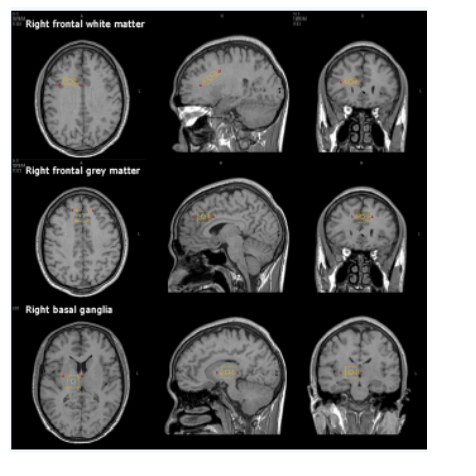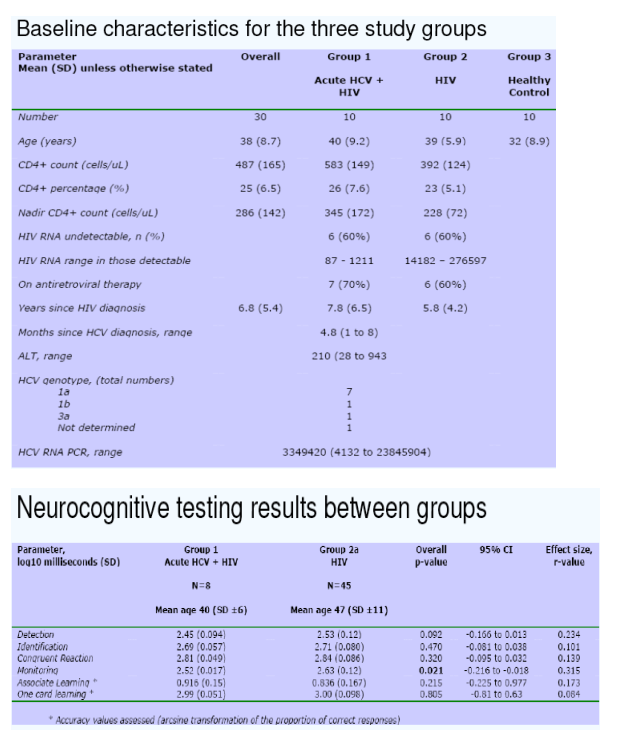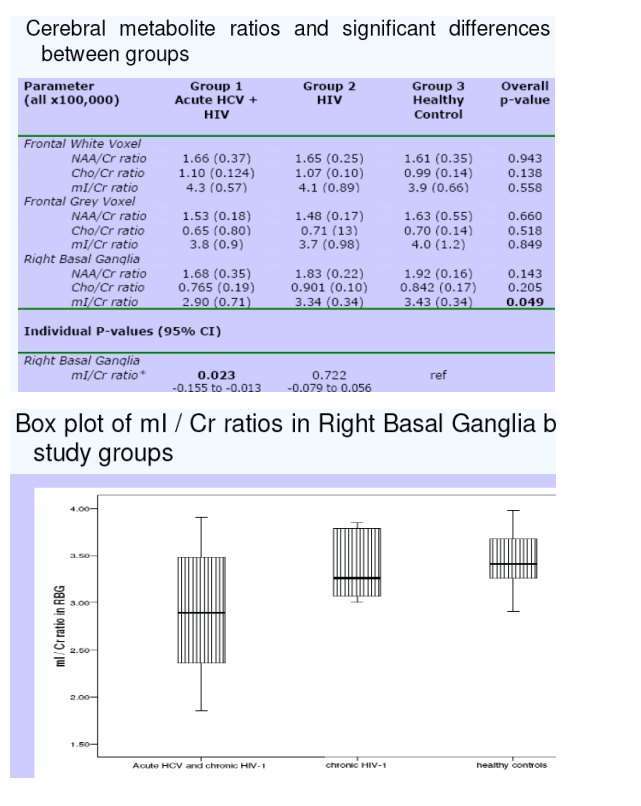 |
 |
 |
| |
HCV Inflames the Brain in HIV Coinfected in Acute HCV
|
| |
| |
Does Acute Hepatitis C Infection Affect the Central Nervous System in HIV-1
Infected Individuals?
Reported by Jules Levin CROI 2009 Montreal Feb 8-12
Summary : Acute HCV in HIV-1 infected subjects is associated with CNS involvement. Clinicians should be vigilant of early CNS involvement when assessing subjects with acute HCV. "acute neuroinflammatory response to the presence of the HCV virus, particularly in those co-infected with HIV"
Alan Winston1,2, Lucy Garvey2, Elizabeth Scotney1, Dharani Yerrakalva1, Joanna M Allsop3, Emma C. Thomson1, Vijay P.B. Grover1,
Janice Main1, Jane Cox3, Marzena Wylezinska3 and Simon D. Taylor-Robinson1,3.
1 Division of Medicine, Imperial College London, London W2 1PG, London, UK
2 Department of HIV Medicine, Imperial College Healthcare NHS Trust, St. Mary's Hospital, London W2 1NY, UK
3 Imaging Sciences Department, MRC Clinical Sciences Centre, Imperial College London, London W12 0HS, UK
Background: Central nervous system (CNS) manifestations of chronic hepatitis C (HCV) and chronic HIV-1 infections reported to date include neurocognitive impairment, altered CNS metabolites and evidence of HCV or HIV-1 replication in the CNS. No studies have assessed the effect of acute HCV infection on the CNS.
Methods: Ten individuals with chronic stable HIV-1 infection with documented acute HCV infection (HCV RNA polymerase chain reaction-positive and HCV antibody-negative, group 1), underwent cerebral proton magnetic resonance spectroscopy (MRS) using acquisition parameters to quantify myo-inositol/creatine (mI/Cr) ratio in the right basal ganglia (RBG). Two matched control groups also underwent MRS: group 2-10 with chronic HIV-1 infection and no evidence of HCV infection; and group 3-10 with no evidence of HIV or HCV. Subjects also underwent computerised neurocognitive assessments (CogState).
Results: RBG mI/Cr ratio in group 1 was significantly lower than groups 2 and 3 (2.90 (±0.7) vs 3.34 (±0.4) and 3.43 (±0.4), mean (SD) for group 1 versus 2 and 3 respectively, p = 0.049) with 50% of subjects in group 1 having a mI/Cr ratio below the lowest observed ratio in either other groups (see the figure). On neurocognitive testing, significant defects in the monitoring domain were observed in group 1, compared to matched controls (p = 0.021).
Conclusions: Acute HCV infection in HIV-1-infected subjects is associated with CNS involvement. Reduced mI/Cr ratio is a marker of infection and immune activation of microglial cells. Clinicians should be aware of early CNS involvement when assessing subjects with acute HCV infection.
AUTHOR CONCLUSIONS: This is the first study to assess the effects of acute HCV viral infection on the central nervous system. We have observed significant reductions in RBG mI/Cr ratio in HIV-1 infected subjects with acute HCV infection. Furthermore, significant abnormalities in neurocognitive function were observed.
The fall in mI/Cr ratio that we have observed was predominantly secondary to a reduction in mI in subjects with acute hepatitis C, although there was a trend towards a raised Cr in this group also (mI (±SD) of 121 (±13) versus 129 (±11) and 130 (±10) and Cr (±SD) of 44 (±8) versus 38 (±4), 39 (±5) in groups 1 versus 2 and 3, p=0.049 and 0.143 respectively). -- Forton [3] et al utilising a similar analytical method also observed changes in mI/Cr ratio in patients with chronic HCV, but reported an increase in this ratio in the FWM, rather than the reductions in mI/Cr that we found in patients with acute HCV. mI is an osmosensitive
glial marker and plays a crucial role in cell volume regulation [4]. Organic osmolytes, such as mI accumulate inside the cell in response to cell shrinkage, and are rapidly released in response to cell swelling via osmoregulated membrane channels [4]. Our findings are novel in patients with acute viral infections, since a low mI/Cr ratio has previously only been observed in patients with end-stage liver disease with established cirrhosis and hepatic encephalopathy, where there are varying degrees of cerebral oedema in response to the presence of unfiltered circulating toxins, such as ammonia, with subsequent regulatory lowering of mI levels in an effort to maintain astrocyte osmotic equilibrium, as the brain swells [5]. Clearly, this is not the mechanism in our cohort with documented acute HCV infection, who may be up to 30 years away from developing HCV-related end-stage liver disease, if their viral infection persisted. We hypothesise that the reduction in mI/Cr ratio we have observed may be an early response to the direct effects of HCV on the CNS and could suggest an initial cellular swelling as part of the acute neuroinflammatory response to the presence of the HCV virus..
- This study is the first report to describe significant effects of acute HCV infection on the CNS in HIV-1 infected subjects. Clinicians should be vigilant for the early-onset of the CNS effects associated with HCV infection, particularly in those co-infected with HIV. Further studies are required to put these results into context, including cerebral positron emission tomography (PET) with the specific ligand [11C](R)-PK11195 as a marker of microglial activation.
INTRODUCTION: Central nervous system (CNS) manifestations of chronic HCV and HIV have been well described [1]. The impact of acute
hepatitis C infection on the CNS are unknown. Frequently acute HCV does not present to healthcare providers. Outbreaks of sexually-transmitted acute HCV in men-who-have-sex-with-men (MSM) with chronic HIV-1 attending for routine healthcare allow an identifiable cohort of subjects with acute HCV to be assessed.
METHODS: Patients attending St. Mary's Hospital, London for HIV care were eligible. Subjects were assigned as cases (chronic HIV and acute HCV, group 1) or HIV-infected controls (chronic HIV infection with no evidence of hepatitis C infection, group 2). A further control group of hospital staff without evidence of HIV or HCV infection were also recruited (group 3).
Acute HCV infection was defined as a positive HCV RNA by PCR testing with a previously negative HCV RNA PCR in the past 6 months. Exclusion criteria for all subjects included: recreational drug dependence and evidence of liver disease.
Study procedures involved undergoing neurocognitive testing (group 1) and cerebral MRS (all groups) on one occasion.
Cognitive Testing : A computerised cognitive test battery was undertaken (CogState) [2]. Control data for cognitive testing were obtained from a separate cohort of HIV-1 infected, age-matched subjects with no evidence of HCV infection (group 2a).
1H-MRS was performed on an Achieva 1.5 Tesla scanner (Phillips, MR Systems, Best, Netherlands) at the Robert Steiner Magnetic Resonance Unit, Hammersmith Hospital, London, UK.
1H-MRS was performed in three voxel locations as below:



|
| |
|
 |
 |
|
|